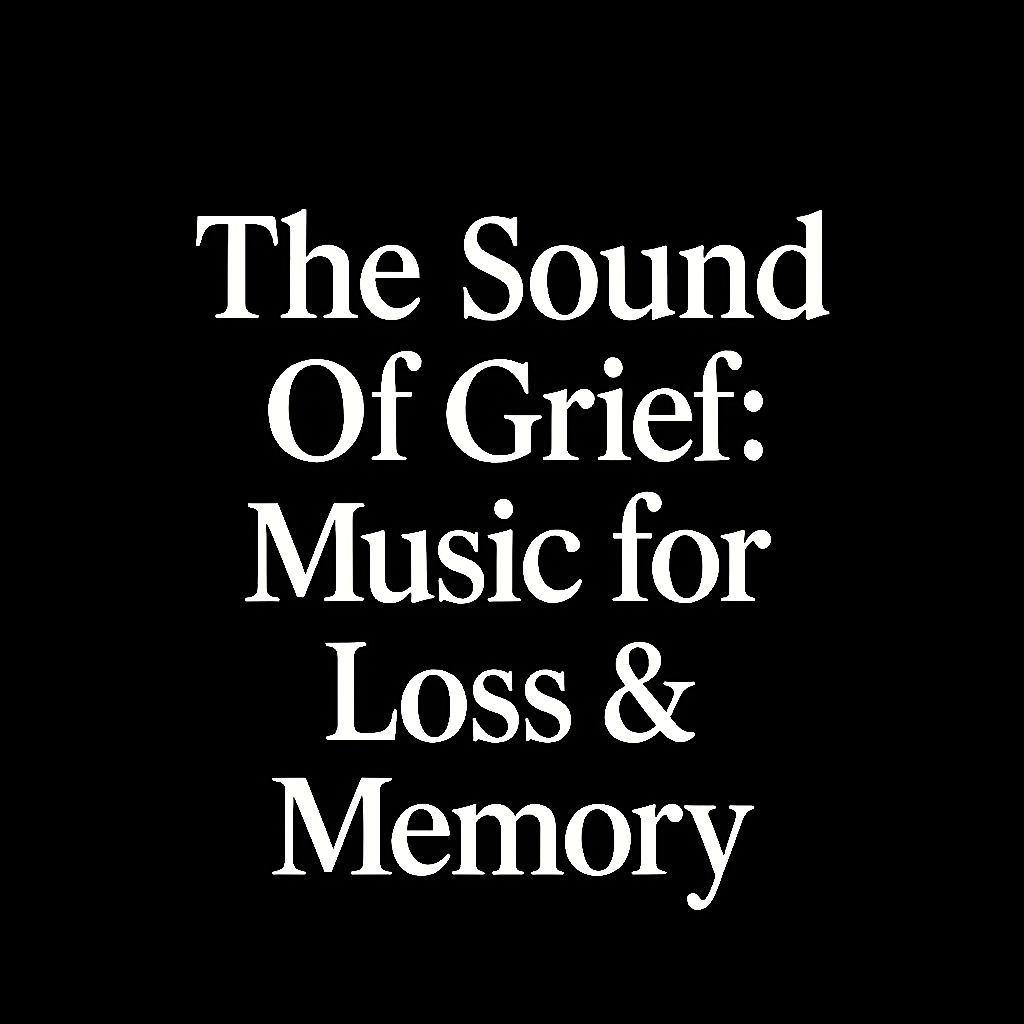The Sound Of Grief: Music for Loss & Memory

There are songs that announce themselves like an arrival, and others that feel like the slow opening of a room’s curtains. Songs about grief often belong to the latter; they ask you to enter, sit down, breathe the still air. They work by subtraction: a solitary instrument left to hang in a cavernous space, a voice so near it picks up your breath, an unresolved chord refusing the comfort of closure. Listening to these songs and albums is not about chasing a hook or chorus. It's about learning how to live with something that remains.
I want to begin with an image from film, because certain albums and cinema speak the same language of absence. In Krzysztof Kieślowski’s Three Colours: Blue, a woman survives a car crash that takes her husband and child. The film is patient. Sound is curated with surgical precision. The recurring score doesn’t heal, it becomes the landscape she inhabits, a sonic architecture of solitude. This is how albums that explore grief often function: not as remedies, but rooms where the wound is visible, and allowed to breathe.
Grief in music isn’t an emotion alone; it asks us to inhabit duration differently. Albums anchored in grief bend time. They slow tempo. They stretch reverb tails, so notes hang like dust motes. They trade complexity for small, human gestures: a repeated single-note figure, an off-hand line that names a small domestic object, the creak of a chair.
These are artistic choices that recur across albums about loss: slow tempi, restrained rhythmic attack, repeated simple motifs, and carefully calibrated silence. The effect is to create elasticity: a song elongates the moment of feeling so the listener can sit inside it without being hurried to a resolution.
There are a few artists I love that write about grief in a way that feels deeply personal to my own experience with it. Artists like Sufjan Stevens, Yebba and Mustafa (aka: Mustafa the Poet). Listen to Mustafa, and you can feel how restraint becomes instrument. His debut project, When Smoke Rises, and recently Dunya, use voice, guitar (and traditional oud), background vocals and audio recordings to suggest memory without narrating it. Silence is treated like another chord, negative space a palette. Each strum hue resonates like a memory turning back into view.
Sufjan Stevens’ Carrie & Lowell is grief rendered as close-up — so intimate it sounds like he’s singing from the pillow next to yours. In Fourth of July, the phrase “We’re all gonna die” repeats until it stops being a statement and becomes a hum of resignation. Should’ve Known Better folds regret into flickers of renewal: a child’s laugh, a patch of sunlight, moments that refuse to be excluded from the frame.
And then there’s The Only Thing, perhaps his most unguarded confrontation with survival. The intrusive thought: “The only thing that keeps me from driving this car / Half-light, jack knife into the canyon at night,” is followed by small, anchoring reasons to stay: the smell of the sea, the touch of another’s hand. His grief is built from fragments: names, places, blunt truths, and gestures so small they could be overlooked. Together, they build an architecture where loss has weight and texture, not just metaphor.
Grief inhabits the personal and universal. Two lyrical devices make it poignant: naming and withholding. Naming is radical because it insists on the existence of a person who is no longer present. Mustafa names. Even when the language is elliptical, the names are anchors: specific people, small domestic details, a thobe, a scent. Mustafa’s songs are acts of memory and resistance. The named object or person makes absence legible. Naming is a small forensic act against the erasure that grief threatens. In Ali, he opens with an invocation: “Ali, you know our hearts were at their fullest / Ali, there were no words to stop the bullets / Concrete dreams, I could never leave / I go back to when we were 13 and 15 and 17.” It’s a direct address across the gap between life and death. Sometimes we lose people through distance, and sometimes we lose parts of ourselves along the way.
His writing knows grief as a contradictory climate: sedimented, ongoing, impossible to leave. In the second verse of Capo, he and Sampha sing:
“And I can't let it go, this feelin' I have won't settle / Won't stop rainin', we're at sea level / And this pain is never gentle / It anchors me into the rubble / But I'm breathin' fine.”
It’s one of the most accurate depictions of grief in music I know. There’s the immovable weight, the quiet violence of pain that doesn’t lessen, and then that final contradiction… still breathing, still alive. Grief here is not an event but a weather system you live inside. Mustafa treats negative space as a palette; every silence, every soft background voice, every oud or guitar strum becomes a memory turning back into view. In other instances, Mustafa captures the grief that happens when you’re just in proximity to someone else’s loss; watching them disappear into their mourning, watching your shared exchanges vanish with them. There’s a different kind of ache in this “collateral grief” — you’re not only losing the person who died; you’re also losing the version of the living who remain. And that grief feeds your own. The guitar becomes a pulse, steady but fragile, as if it’s holding up the scaffolding of a relationship that’s already fading.
When we think of Skinny Love, by Bon Iver, we often frame it as a breakup song. But if you listen with loss in mind, it shifts. It’s the sound of something beautiful collapsing under its own weight, the language sparse, almost stammered. Bon Iver’s For Emma, Forever Ago employs cold production and thin, reedy vocals like an audio winter. Garbled harmonies, layered breaths, distant textures; it all evokes isolation. As a listener, you become cocooned within the album’s sonic chill, experiencing grief not as performance, but as one’s own interior climate.
I like to imagine an album as a cast: each instrument plays a role. A layered vocal becomes memory refracted. The piano is a room’s furniture: it carries weight, but it also gets left untouched, its resonance indicating absence. A muted trumpet, the distant echo of closeness lost. The electric guitar is often the intruder; single notes that arrive like memory flashes. A cello or low-register brass can function as a kind of body — warm, heavy, always returning.
Bon Iver’s treated vocals feel like history turned spectral. Sufjan Steven’s piano tones feel like floors leaking their own stories. Mustafa’s minimalism allows a single oud strum to carry the hue of feeling itself. These choices are psychological geography, they invite us into emotional landscapes, not just lyrics.
Filmmakers build grief into their frame. In Three Colours: Blue, music and colour compose absence rather than resolution. In Maborosi, (by my favourite director of all time) Hirokazu Kore-eda, grief is domestic rhythm — lived, not dramatic. Silence, routine, quiet detail becomes emotional weight.
Mainstream Hollywood films do this too. Manchester by the Sea uses silence (a limp linger, a slowed shot) to make grief communal without spectacle. Charlotte Wells’s Aftersun uses home-video fuzz and memory’s edge to collapse past and present, making the frame itself haunted. These cinematic strategies parallel music’s use of lo-fi warmth, textured ambience, and detail that anchors rather than narrates. Albums about loss borrow the ellipsis cut: in film, a transition that skips time or detail; in music, a pause or shift that speaks volumes through absence.
There is a quieter, structural element to grief albums that rewards attention: sequencing. Unlike pop albums built for singles and viral hits, albums about grief often follow an internal dramaturgy. The order of songs maps phases, not tidy stages, but moods where some tracks are moments of stunned paralysis, others are near-rants, and some reach for a brittle peace. The sequencing can mimic film editing: a flashback sequence here, a montage of domestic detail there, followed by a long fade.
And then there’s the music we play in our darkest moments: the track that scores your drive home from a funeral, or the drive out of the cemetery once names were spoken and farewells said. The music you have on repeat the first night without them. Those songs become forever tethered to that moment of grief — the air, the light, the ache that settles behind your chest. They become a time capsule, inseparable from loss. Such songs become emotional coordinates, marking where grief entered you and where it still lingers.
Whether you call them grief albums or albums about loss, one thing is true for all: these types of albums ask work of their listeners. They do not supply catharsis as a finished product. They create a space to practice feeling. That is why these albums sometimes feel like quiet companions at odd hours, songs that you play at 2AM or on the long drive home.
The private nature of streaming suits grief’s intimacy. It allows the listener to inhabit the album alone, to make its ritual personal. However, this intimacy is not always a virtue. The ritual of listening in solitude offers comfort but it can also curtail communal mourning. Grief can become personalized therapy rather than an invitation to shared responsibility. Still, for many listeners (myself included), the private album is a lifeboat. It is a place to organize feelings that the rest of life will not allow.
They also perform a quiet civic function. In a culture obsessed with numbers and headlines, albums about loss refuse flattening. They keep the personal story alive, not as a headline, but as vivid living memory. That resistance feels necessary. It’s not sentimental, it’s intention.
Albums about loss and grief aren’t cures; they’re rituals. You return to them like entering a dim room you know: you remember the floorboard’s creak, the furniture’s shape, the light at the window. They give grammar to loss. The silence between notes, the whisper in the lyric, becomes how you remember… and keep living.
So, when a voice sings you home through your grief… Mustafa’s soft lamentations, Sufjan’s intimate confession, Bon Iver’s winter hush, pay attention. Listen to the silences. Notice a name left unsaid, or a chord that fades mid-phrase. These songs don’t tell you how to stop missing someone, they teach you how to keep missing, without losing yourself.
An intrinsic part of honouring someone is honouring what they made you feel when they left. If you can acknowledge that and preserve it, you preserve them because a large part of loss is about what we do with the void they leave behind. How we talk about the void, how we speak their name, how we keep telling the story of what they meant. That, too, is remembrance. And sometimes, remembrance is a form of love. Maybe every loss, every burial, every heartbreak will make sense in the end. Maybe, if we leave the door open, they will return — not as they were, but in the form that heals us most. And if not, perhaps the music can hold our broken pieces together.






